
Quercus palustris, also called pin oak, swamp oak, or Spanish oak, is a tree in the red oak section of the genus Quercus. Pin oak is one of the most commonly used landscaping oaks in its native range due to its ease of transplant, relatively fast growth, and pollution tolerance.
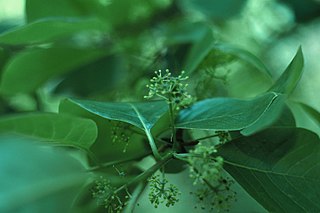
Tupelo, genus Nyssa, is a small genus of deciduous trees with alternate, simple leaves. It is sometimes included in the subfamily Nyssoideae of the dogwood family, Cornaceae, but is placed by other authorities in the family Nyssaceae. In the APG IV system, it is placed in Nyssaceae.
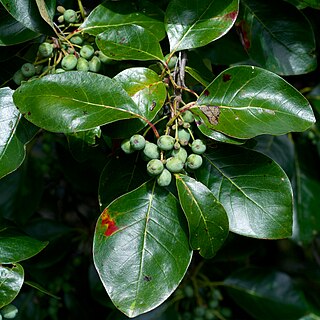
Nyssa sylvatica, commonly known as tupelo, black tupelo, blackgum or sour gum, is a medium-sized deciduous tree native to eastern North America from the coastal Northeastern United States and southern Ontario south to central Florida and eastern Texas, as well as Mexico.

Quercus laurifolia is a medium-sized semi-evergreen oak in the red oak section Quercus sect. Lobatae. It is native to the southeastern and south-central the United States.
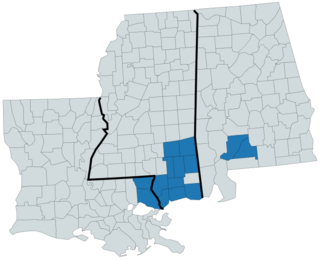
Isoetes louisianensis, the Louisiana quillwort, is a small, grass-like aquatic plant of the family Isoetaceae. It is "one of the rarest quillworts in North America." It occurs in only five locations in St. Tammany and Washington Parishes of Louisiana, as well as some spots in southern Mississippi and south-central Alabama. It is federally listed as an endangered species, partly due to its highly restricted range.

Taxodium distichum is a deciduous conifer in the family Cupressaceae. It is native to the southeastern United States. Hardy and tough, this tree adapts to a wide range of soil types, whether wet, salty, dry, or swampy. It is noted for the russet-red fall color of its lacy needles.
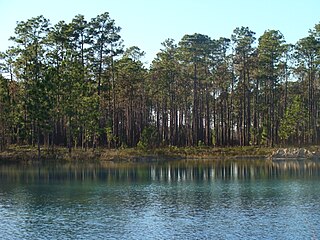
The Apalachicola National Forest is the largest U.S. National Forest in the state of Florida. It encompasses 632,890 acres and is the only national forest located in the Florida Panhandle. The National Forest provides water and land-based outdoors activities such as off-road biking, hiking, swimming, boating, hunting, fishing, horse-back riding, and off-road ATV usage.

Annona glabra is a tropical fruit tree in the family Annonaceae, in the same genus as the soursop and cherimoya. Common names include pond apple, alligator apple, swamp apple, corkwood, bobwood, and monkey apple. The tree is native to Florida in the United States, the Caribbean, Central and South America, and West Africa. It is common in the Everglades. The A. glabra tree is considered an invasive species in Sri Lanka and Australia. It grows in swamps, is tolerant of saltwater, and cannot grow in dry soil.
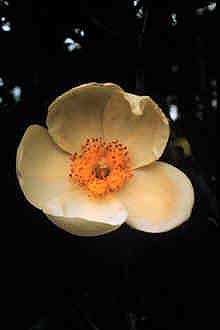
Gordonia lasianthus is a small to medium-sized evergreen tree or shrub found in acidic, swampy soils of pinelands and bays on the Atlantic and Gulf Coastal Plains of the southeastern United States. It is a member of the tea or family Theaceae. It is slow growing with soft, light-colored, fine-grained wood of little commercial value, although loblolly-bay could be managed as a source of pulpwood. When older specimens are cut, the wood exudes a strong scent. It is similar to a mixture of fresh oranges and pine sap. The bark of the adult tree varies from medium grey to a red brown coloration. Dead adult specimens of loblolly bay exhibit a lustrous shine when exposed to sunlight for several years. The white showy flowers and shiny foliage make it a desirable ornamental, but it is not easy to cultivate. Deer browse stump sprouts heavily.

Salix nigra, the black willow, is a species of willow native to eastern North America, from New Brunswick and southern Ontario west to Minnesota, and south to northern Florida and Texas.

Nyssa aquatica, commonly called the water tupelo, cottongum, wild olive, large tupelo, tupelo-gum, or water-gum, is a large, long-lived tree in the tupelo genus (Nyssa) that grows in swamps and floodplains in the Southeastern United States.

The Middle Atlantic coastal forests are a temperate coniferous forest mixed with patches of evergreen broadleaved forests along the coast of the southeastern United States.

Eubotrys racemosa is a species of flowering plant in the heath family known by the common names fetterbush, swamp doghobble, and swamp sweetbells.

Lyonia lucida is a species of flowering plant in the family Ericaceae known by the common names fetterbush lyonia, hurrahbush, and staggerbush. Other plants may also be called fetterbush. This broadleaved evergreen plant grows on the coastal plain of the southeastern United States from Virginia to Florida to Louisiana. It also occurs in Cuba.
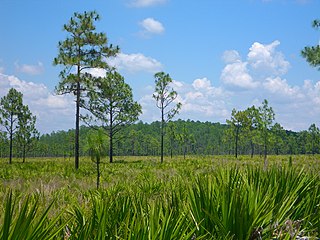
A cypress dome is a type of freshwater forested wetland, or a swamp, found in the southeastern part of the United States. They are dominated by the Taxodium spp., either the bald cypress, or pond cypress. The name comes from the dome-like shape of treetops, formed by smaller trees growing on the edge where the water is shallow while taller trees grow at the center in deeper water. They usually appear as circular, but if the center is too deep, they form a “doughnut” shape when viewed from above. Cypress domes are characteristically small compared to other swamps, however they can occur at a range of sizes, dependent on the depth.

The Southeastern conifer forests are a temperate coniferous forest ecoregion of the southeastern United States. It is the largest conifer forest ecoregion east of the Mississippi River. It is also the southernmost instance of temperate coniferous forest within the Nearctic realm.
The southern coastal plain blackwater river floodplain forest is a forest system found in Alabama, Mississippi, Florida, and Georgia. These forests occur in the drainages of blackwater rivers and streams whose dark water is caused by high levels of tannins, particulates, and other materials accumulated as they drain through swamps and marshes. The water has little mineral sediment and few suspended clay particles.

The Southern coastal plain nonriverine basin swamp is a wetland system found along the southern Atlantic coastal plain and the eastern Gulf coastal plain, and extending into the Florida peninsula. These wetlands occur in large, seasonally flooded depressions away from rivers. Sites are often forested by trees including bald cypress, swamp tupelo, evergreen shrubs, and hardwoods. Slash pine is sometimes found. Characteristic shrubs include buckwheat tree, swamp cyrilla, fetterbush lyonia, and laurelleaf greenbrier.
The southern coastal plain nonriverine cypress dome is a forested wetland community found in the southern Atlantic coastal plain, in the states of Alabama, Florida, Georgia, Louisiana, and Mississippi.

Turkey Creek is a stream in Texas, United States. It rises in Central Tyler county and flows 30 miles (48 km) before converging with Village Creek, east of Kountze, Hardin County. It passes through the 8,032-acre (3,250 ha) Turkey Creek Unit of the Big Thicket National Preserve on its way south.



















